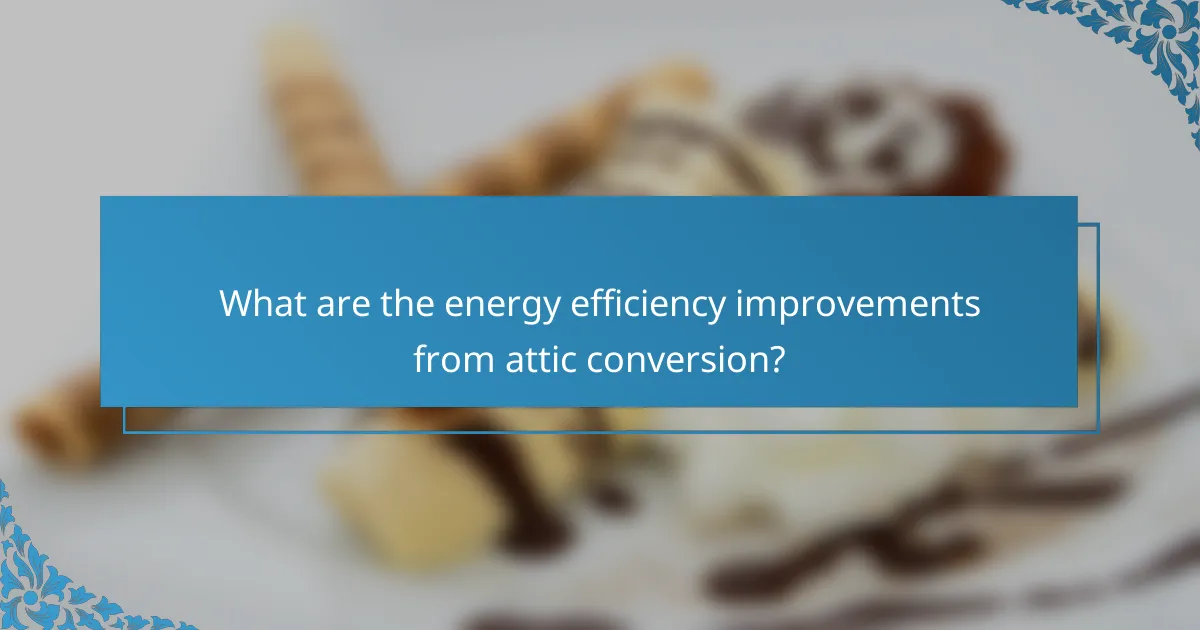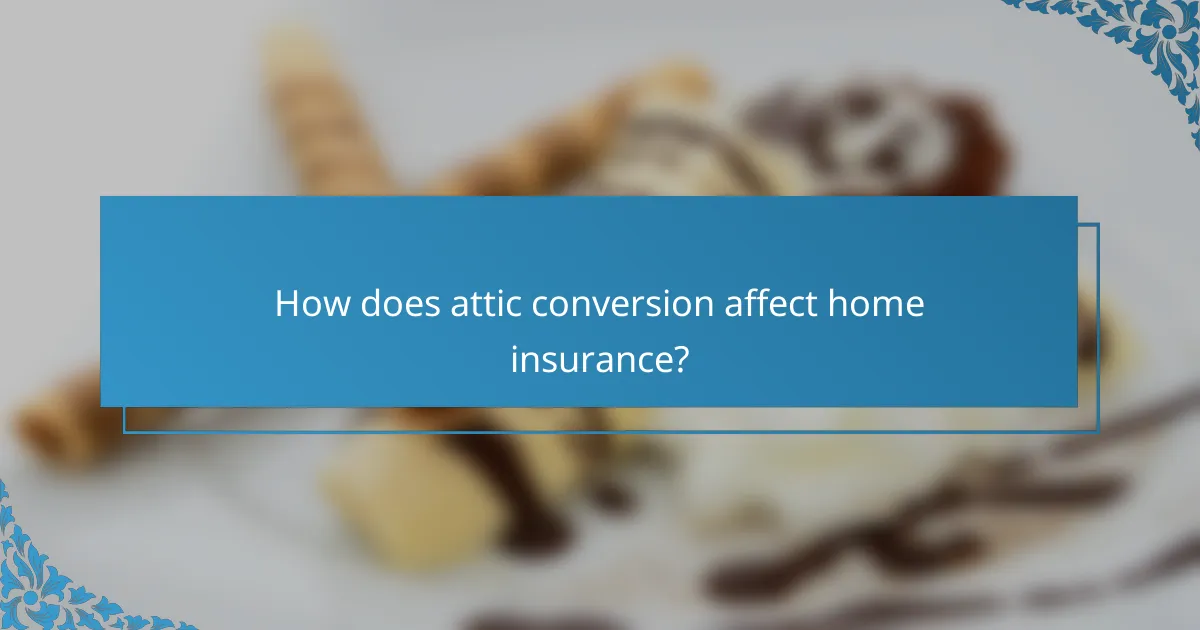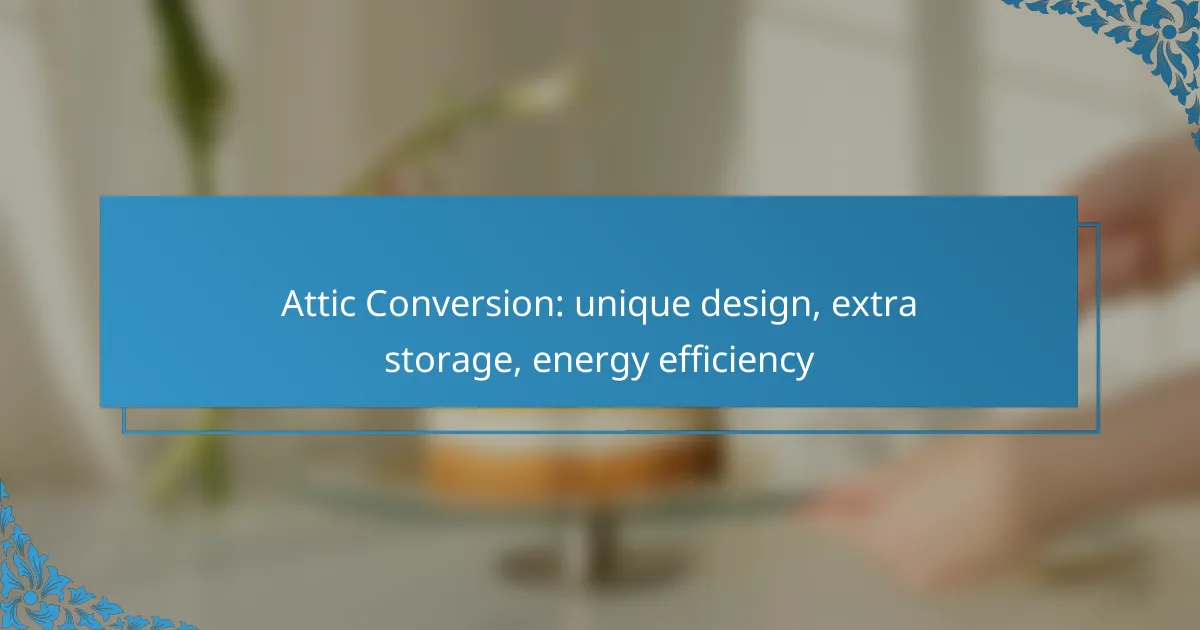Converting your attic can significantly enhance your home by maximizing living space, increasing property value, and improving energy efficiency. With a range of design options available, from modern to traditional, homeowners can create functional and aesthetically pleasing rooms while also benefiting from additional storage. Investing in an attic conversion not only transforms unused areas but also offers long-term value for your property.

What are the benefits of attic conversion in Toronto?
Attic conversion in Toronto offers several advantages, including maximizing living space, increasing property value, and enhancing energy efficiency. Homeowners can transform unused areas into functional rooms, making the most of their investment.
Increased living space
Converting your attic into a usable space can significantly increase your home’s living area. This additional space can serve various purposes, such as a bedroom, office, or playroom, catering to your family’s needs. Utilizing this often-overlooked area can eliminate the need for costly extensions or moving to a larger home.
When planning an attic conversion, consider the height and layout of the space. A minimum headroom of around 2.4 meters is ideal for comfortable living. If your attic is too low, you may need to raise the roof, which can add to the project’s cost.
Enhanced property value
Converting your attic can lead to a substantial increase in your property’s market value. Homes with additional living space are often more appealing to buyers, particularly in urban areas like Toronto where space is at a premium. A well-executed attic conversion can yield a return on investment of around 70% to 80% when selling.
Before starting the conversion, research local market trends to determine the most desirable features. For instance, creating an extra bedroom or a dedicated office space can attract potential buyers and enhance your property’s appeal.
Improved energy efficiency
Attic conversions can improve your home’s energy efficiency by ensuring better insulation and ventilation. Proper insulation helps maintain a consistent temperature, reducing heating and cooling costs. This is particularly important in Toronto, where winters can be harsh and summers can be hot.
When converting your attic, consider installing energy-efficient windows and using sustainable materials. This not only reduces energy consumption but can also qualify you for local energy efficiency grants or incentives, making the project more financially viable.

How much does an attic conversion cost in Ontario?
The cost of an attic conversion in Ontario typically ranges from CAD 20,000 to CAD 60,000, depending on various factors such as size, design, and materials used. Homeowners should consider both the upfront costs and potential increases in property value when planning their project.
Average cost range
The average cost for an attic conversion in Ontario generally falls between CAD 25,000 and CAD 50,000. This range can vary based on the complexity of the design and the quality of materials selected. Simple conversions may be on the lower end, while high-end finishes and structural changes can push costs higher.
In some cases, homeowners may encounter additional expenses for permits, inspections, and potential structural reinforcements, which can add several thousand dollars to the overall budget.
Factors affecting pricing
Several factors can influence the pricing of an attic conversion in Ontario. The size of the attic plays a significant role; larger spaces typically require more materials and labor, increasing costs. Additionally, the complexity of the design, such as the inclusion of bathrooms or custom features, can further impact the total expense.
Local labor rates and the choice of contractors also affect pricing. It’s advisable to obtain multiple quotes from reputable contractors to ensure competitive pricing. Lastly, any necessary upgrades to insulation or electrical systems to meet building codes can add to the overall cost of the project.

What design options are available for attic conversions?
Attic conversions offer a variety of design options that can enhance both aesthetics and functionality. Homeowners can choose from modern minimalist designs to traditional cozy styles, each providing unique benefits and considerations for space utilization and energy efficiency.
Modern minimalist designs
Modern minimalist designs focus on simplicity and functionality, often featuring clean lines and open spaces. This style typically uses neutral color palettes and minimal furnishings to create a spacious feel, making the most of natural light.
When considering a modern minimalist attic conversion, prioritize large windows or skylights to enhance brightness. Built-in storage solutions can help maintain a clutter-free environment, while sleek furniture can complement the overall aesthetic.
Traditional cozy styles
Traditional cozy styles emphasize warmth and comfort, often incorporating rustic elements like exposed beams, wood paneling, and soft textiles. This design creates an inviting atmosphere, perfect for a bedroom or reading nook.
For a traditional cozy attic conversion, consider using warm color schemes and vintage furnishings. Adding features like a small fireplace or built-in bookshelves can enhance the charm, while ensuring adequate insulation will improve energy efficiency and comfort throughout the year.

What permits are required for attic conversions in Canada?
In Canada, attic conversions typically require building permits and adherence to zoning regulations. These permits ensure that the conversion meets safety standards and local codes.
Building permits
Building permits are essential for any structural changes, including attic conversions. They ensure that the work complies with the National Building Code of Canada and local municipal codes. The application process may involve submitting detailed plans and specifications of the proposed conversion.
Costs for building permits can vary widely, often ranging from a few hundred to over a thousand Canadian dollars, depending on the municipality and the complexity of the project. It’s advisable to check with your local building authority for specific requirements and fees.
Zoning regulations
Zoning regulations dictate how properties can be used and may affect your attic conversion plans. These regulations can include restrictions on the height of buildings, the type of occupancy, and the overall footprint of the structure. Understanding these rules is crucial to avoid potential legal issues.
Before proceeding, verify that your property is zoned for residential use and check if there are any neighborhood-specific guidelines. Engaging with a local architect or planner can help navigate these regulations effectively.

How to choose a contractor for attic conversion?
Choosing a contractor for an attic conversion involves evaluating their qualifications, experience, and past work to ensure they can deliver a high-quality result. Focus on contractors who specialize in attic renovations and have a solid reputation in your local area.
Check credentials and experience
Start by verifying the contractor’s credentials, including licenses and insurance. A licensed contractor is typically required to meet local building codes and regulations, which can vary by region.
Experience is crucial; look for contractors who have completed several attic conversions. Ideally, they should have at least five years of experience in this specific area of home renovation, as this indicates a solid understanding of the unique challenges involved.
Review past projects
Request to see a portfolio of the contractor’s previous attic conversion projects. This will give you insight into their design style and quality of workmanship. Look for projects that are similar in scope to what you envision for your own attic.
Additionally, consider reaching out to past clients for references. Ask about their experience with the contractor, including communication, adherence to timelines, and overall satisfaction with the finished project. This feedback can help you gauge the contractor’s reliability and professionalism.

What are the energy efficiency improvements from attic conversion?
Attic conversion can significantly enhance energy efficiency by improving insulation and incorporating energy-efficient windows. These upgrades help maintain a stable indoor temperature, reduce energy consumption, and lower utility bills.
Insulation upgrades
Upgrading insulation in an attic conversion is crucial for energy efficiency. Proper insulation minimizes heat loss in winter and keeps the space cooler in summer, which can lead to energy savings of around 20-30% on heating and cooling costs. Consider using materials like spray foam or fiberglass batts, which are effective in sealing gaps and preventing air leaks.
When selecting insulation, aim for a minimum R-value of 30-49, depending on your local climate. In colder regions, higher R-values are recommended to ensure optimal thermal performance. Always check local building codes for specific insulation requirements.
Energy-efficient windows
Installing energy-efficient windows during an attic conversion can significantly improve thermal performance. Look for windows with a low U-factor and high solar heat gain coefficient (SHGC) to ensure they provide excellent insulation and reduce heat transfer. Double or triple glazing is often recommended for optimal efficiency.
Consider using low-emissivity (Low-E) coatings on glass to reflect heat while allowing natural light. This can further enhance energy savings and comfort. Additionally, ensure proper sealing and installation to prevent air leaks, which can undermine the benefits of your new windows.

What are common challenges in attic conversions?
Attic conversions often face several challenges that can impact the overall feasibility and success of the project. Key issues include structural limitations, access and egress problems, and compliance with local building regulations.
Structural limitations
Structural limitations refer to the existing framework of the attic space, which may not support the intended conversion. Many attics have sloped roofs, low ceilings, or inadequate load-bearing walls, which can restrict usable space and design options.
Before starting an attic conversion, it’s essential to assess the structural integrity of the space. Engaging a structural engineer can help determine if reinforcements are needed and what modifications are feasible. For instance, adding support beams or adjusting roof angles may be necessary to create a functional living area.
Access and egress issues
Access and egress issues involve the means of entering and exiting the attic safely. Many attics lack proper staircases or have steep, narrow stairs that can be hazardous. Building codes typically require safe and adequate access for both occupants and emergency services.
To address these issues, consider installing a full staircase that meets local building codes. This may involve reconfiguring existing spaces to accommodate a safe and accessible stairway. Additionally, ensure that there are adequate escape routes, such as windows that can be opened or large enough to serve as emergency exits.

How does attic conversion affect home insurance?
Attic conversions can impact home insurance by potentially increasing the property’s value and altering the risk profile. Insurers may adjust premiums based on the added living space and any renovations made.
Increased property value
Converting an attic into usable space typically raises the overall value of a home. This increase may lead to higher insurance premiums, as the insurer will need to cover the enhanced value. It’s advisable to inform your insurance provider about the conversion to ensure adequate coverage.
Risk assessment changes
With an attic conversion, the risk profile of your home may change. Factors such as structural modifications, fire safety, and occupancy levels will be reassessed. Insurers may require additional safety measures, like smoke detectors or reinforced flooring, to mitigate potential risks.
Policy adjustments
After an attic conversion, you may need to adjust your home insurance policy. This could involve increasing coverage limits or adding endorsements for specific features, such as a bathroom or kitchen. Review your policy carefully and consult with your insurer to ensure all aspects of the conversion are covered.
